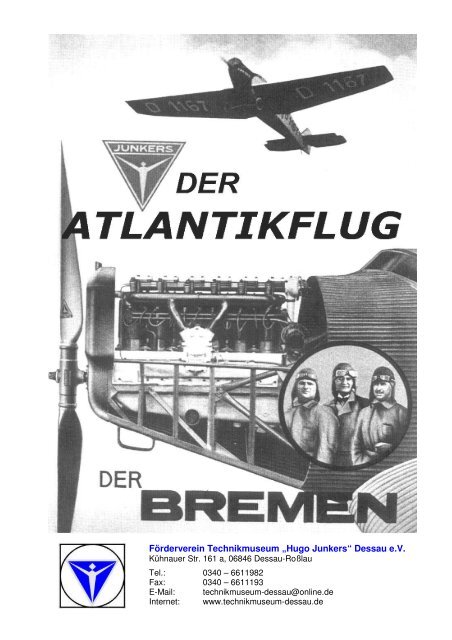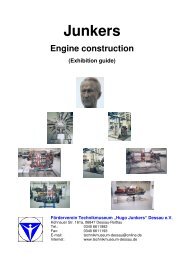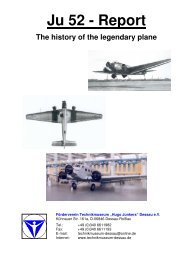1 Förderverein Technikmuseum „Hugo Junkers“ Dessau e.V.
1 Förderverein Technikmuseum „Hugo Junkers“ Dessau e.V.
1 Förderverein Technikmuseum „Hugo Junkers“ Dessau e.V.
Create successful ePaper yourself
Turn your PDF publications into a flip-book with our unique Google optimized e-Paper software.
<strong>Förderverein</strong> <strong>Technikmuseum</strong> <strong>„Hugo</strong> <strong>Junkers“</strong> <strong>Dessau</strong> e.V.<br />
Kühnauer Str. 161 a, 06846 <strong>Dessau</strong>-Roßlau<br />
Tel.: 0340 – 6611982<br />
Fax: 0340 – 6611193<br />
E-Mail: technikmuseum-dessau@online.de<br />
Internet: www.technikmuseum-dessau.de<br />
1
East-West Trans-Atlantic Crossing<br />
In 1927 Charles Lindberg, an American, overflew the Atlantic in his Ryan NYP “Spirit of St. Louis” in west-east<br />
direction.<br />
Inspired with the idea of crossing the Atlantic in the opposed direction, from east to west, the initiator of the<br />
BREMEN flight baron von Hünefeld set everything in motion in order to put his thoughts into practise. His<br />
reason for going on this journey was solely to improve international understanding and not to create a sensation<br />
out of it. Ten years upon completion of the First World War, he wanted to set an example with this flight, which<br />
should have helped to encourage understanding between both former opponents of war, Germany and the<br />
United States of America. As a spokesman of North German Lloyd at that time, he had the appropriate relations<br />
to find money for this flight. Today one would say: the sponsors were generous.<br />
As an adviser for aeronautical affairs, he was able to win the Bremen pilot Cornelius Edzard over. After the<br />
money for this flight was available, both of them started to look for an appropriate aeroplane. A new machine of<br />
Junkers aeroplane works from <strong>Dessau</strong>, Junkers W33, was chosen.<br />
During the inspection of the chosen aeroplane in <strong>Dessau</strong>, Hünefeld got to know Herman Köhl, a flight expert<br />
and a pilot from Lufthansa. Hünefeld managed to inspire the Junkers pilots, Ristisz and Loose, with his idea.<br />
The representative of the American Hearstpresse in Germany offered himself as a new investor for that project.<br />
Thus, enough money was available to send two aeroplanes on the journey to America.<br />
Because one of the main investors of this project was North German Lloyd , both Junkers W33 were named<br />
after the passenger steamers, BREMEN and EUROPA.<br />
W33 was built as a cargo aircraft and a long haul aircraft. Its fuselage offered, therefore, enough space for<br />
additional tanks needed for the long reach to America. Corresponding reconstruction and test flights were<br />
carried out. On the basis of positive results obtained at the test flights, the appointment for crossing the Atlantic<br />
was fixed for 14.08.1927.<br />
Around 18:25 both machines, one after another, took off in direction Newfoundland. Due to bad weather and<br />
problems with Junkers L5 engine, both machines were forced to return back rapidly. The aeroplane EUROPA<br />
was broken down as it tried to land. As a result of those negative happenings and disposition within the<br />
population, North German Lloyd and Hearstpresse gave up supporting this project. However, von Hünefeld<br />
succeeded in inspiring traders from Bremen for his project, so that he could buy the aeroplane BREMEN for that<br />
money. The pilot, Cornelius Edzard, was no longer available for an anew flight, this means that the way was<br />
free for Herman Köhl. Already in winter Hünefeld and Köhl began preparations for an anew crossing of the<br />
Atlantic. Technical changes were carried out extensively on W33 BREMEN. Because disposition in Germany<br />
was still against this undertaking, both of them were looking for aerodromes abroad. The most suitable<br />
aerodrome for them was Baldonnel, in Ireland. The airfield was peered and the airport commandant, major<br />
James C. Fitzmaurice, offered a full support to them. In the early morning of 26 March, BREMEN took off from<br />
Berlin airport Tempelhof<br />
in Baldonnel direction. The flight target given to the authorities was, however, <strong>Dessau</strong>. The reason for that, the<br />
mechanic Spindler and baron von Hünefeld were on board. If the authorities had known that von Hünefeld was<br />
on board as an official member of the crew, they would not have granted a permit for that flight, so he had to<br />
hide on board to take part in this flight. The flight went according to plan.<br />
3
Though, the three crew members - Köhl, von Hünefeld and Spindler - were put to acid the test. Because of foul<br />
weather, the take-off had to be consistently postponed. During that time of everlasting waiting, Köhl and von<br />
Hünefeld made friends with Fitzmaurice. Both of them decided to take him on the journey instead of Spindler.<br />
Shortly after the weather became<br />
better, the BREMEN took off with<br />
Köhl and Fitzmaurice at the helm,<br />
and von Hünefeld in the freight<br />
behind of the additional tanks, on<br />
12.04.1928 around 05:38 local<br />
time. Although the soil was<br />
softened, due to foul weather,<br />
Fitzmaurice was able to manage<br />
the circumstances. In the end the<br />
machine gained on speed and<br />
could start in direction America. At<br />
a rate of about 200 km/h, the<br />
BREMEN covered a distance of<br />
1,500 km with its crew. Foul<br />
weather emerged suddenly and<br />
caused technical problems, which<br />
made the navigation in the night<br />
difficult. On 13.04.1928 the crew<br />
was surprised to find forested hills<br />
beneath them. They flew over that<br />
inhuman wilderness for hours.<br />
The fuel was running short when<br />
Fitzmaurice discovered a<br />
lighthouse suddenly. It was the lighthouse of the small island Greenly Island situated between Labrador and<br />
Newfoundland. The opportunity for landing on the island was immediately put into action. Köhl landed the<br />
machine on a small pound covered with snow and ice.<br />
Unfortunately, the ice was not hard enough and the machine broke into the pound. Chassis and propeller were<br />
damaged. But that did not bother the crew that much because they knew that their common purpose was<br />
already achieved. The keeper of the lighthouse and his family offered their hospitality to the crew of BREMEN<br />
and provided them with necessary things. Thousands of spectators were waiting in vain for the arrival of<br />
BREMEN in New York few thousands kilometres away, more precisely 1,800 km.<br />
4
No more than four hours later, people in Europe also came to know by means of radio and media, that<br />
BREMEN would not reach New York anymore, but that it had landed in Canada.<br />
The attempt to fly the repaired BREMEN from Canada to New York was miscarried. It broke down at the same<br />
place. On 28 April 1928 three crew members, Köhl, Fitzmaurice and von Hünefeld, were accepted<br />
enthusiastically by the population of New York. In their honour a ticker-tape parade was arranged.<br />
On the basis of their particular aeronautical performance, one law was modified, so that the president of the<br />
United States of America gave the highest distinction for a pilot, “the Distinguished Flying Cross”, to them. The<br />
three pilots were welcomed by an enthusiastic crowd in Bremen on 19 June 1928 and honoured by the senate<br />
of Bremen. The damaged BREMEN was brought back to Germany on board of a cargo ship of North German<br />
Lloyds. It was repaired at the Junkers works in <strong>Dessau</strong> and ,after that, it was never flown again.<br />
Baron von Hünefeld searched vainly for a place, where that historical aeroplane could be housed. He was<br />
rejected everywhere. Even the German museum in Munich was not interested in BREMEN. Von Hünefeld was<br />
appalled at much ignorance, so that he finally gave BREMEN to the American people. The machine was<br />
returned to America on board of COLUMBUS. There, it was exhibited at several museums till finally it was<br />
bought by Henry Ford for his Museum in Dearborn and remained there till 1997. It was brought back to<br />
Germany by the association “Wir holen die BREMEN nach Bremen e.V”, a union of Bremen citizens. By June<br />
1998 it was restored at the shipyard of Lufthansa Flight Training in Bremen.<br />
Biographical Information<br />
James C. Fitzmaurice<br />
was born in the capital of Ireland, Dublin, on 6 January 1898. After his sortie, he was trained to a pilot. He<br />
proved himself by flying to Germany as a pilot of the post. During the Irish Civil War, he flew for the freedom<br />
army. Already in 1926 he became Commandant of the Irish aeronautical corps. He died in Dublin on 26<br />
September 1965.<br />
Ehrenfried Günther Baron von Hünefeld<br />
was born in Königsberg, Germany, on 1 May 1892. He got gravely injured in the First World War, after that he<br />
joined the foreign service. In 1923 he accepted office as the promotional director of North German Lloyd. In<br />
autumn 1928 he flew together with a Swedish pilot in EUROPA to Tokyo. Von Hünefeld died in Berlin on 5<br />
February 1929 and was buried at Seglitzer cemetery.<br />
Hermann Köhl<br />
was born in New-Ulm on 15 April 1888. In the First World War, he was a commandant of a bomb squadron. In<br />
1926 he was in charge of the night flight traffic of Lunfthansa.<br />
He addressed himself to different aeronautical tasks after the Atlantic flight.<br />
On 7 October he passed the way and was entombed in Pfaffenhofen an der Roth.<br />
5
What has remained?<br />
Only a vague reminiscence of the ocean-flight? Only the names of three pioneers of air traffic?<br />
Well, valuable exhibits from the aircraft captain’s inheritance can be seen in the town hall of Pfaffenhofen a.d.<br />
Roth at Hermann-Köhl museum.<br />
Grüttert-Uhren museum in Bremen, Sögestraße 70, attends to the Junkers W 33 Bremen- archive.<br />
Furthermore, a wooded relief in the Hansestadt at the Böttcherstaße reminds of this daring attempt.<br />
Visitors of the New Town Hall can already read on the left side of the entrance, appreciation words written on a<br />
memorial tablet, formulated by the German chancellor Schröder.<br />
A picture of Alex Kircher gives an impression of BREMEN, as it overflew the Atlantic.<br />
At the airport there are three streets named after Hermann Köhl, von Hünefeld and Fitzmaurice.<br />
At the public record office contemporary books, reports, newspaper announcements and photographs are<br />
accumulated.<br />
Sources:<br />
Karl-August Blendermann “Atlantikflug D1167” Publisher H.M. Hauschild GmbH- Bremen<br />
Horst Brinkmann „Airport Bremen Restaurierung der Junkers W33 in Bremen“, Publisher: Stedinger Verlag –<br />
Lemwerder<br />
„Die Deutsche Illustrierte“ (The German Magazine) Sondernummer vom (special number of) 14. April 1928;<br />
Berlin<br />
6





